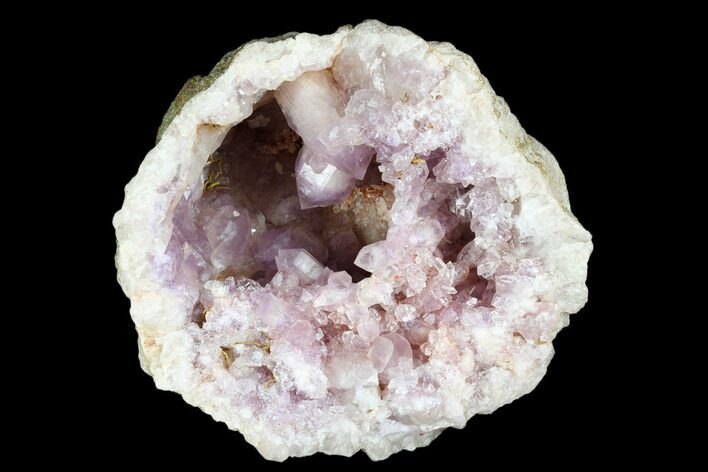This Specimen has been sold.
3.4" Sparkly, Lavender Amethyst Geode Half - Argentina
This is a beautiful find out of Argentina, featuring true pink amethyst crystals with calcite, collected from the Choique Mine. It occurs in geodic formations or cavities lined with crystals. This specimen is a rare, lavender color, which is highly unusual for pink amethyst.
This geode half is 3.4" wide and comes with an acrylic display stand.
This geode half is 3.4" wide and comes with an acrylic display stand.
This material has been analyzed at the California Institute of Technology and was described as "purplish pink amethystine quartz additionally coloured by microscopic hematite particles". They are not rose quartz or pink quartz as classically defined.
Pink amethyst is formed by the same processes that gives amethyst its purple color, but by definition amethyst is purple, not pink. Thus, we are left with a conundrum of what to call it! But since the majority of people seem to be calling it "pink amethyst", we will stick with that label.
Pink amethyst is formed by the same processes that gives amethyst its purple color, but by definition amethyst is purple, not pink. Thus, we are left with a conundrum of what to call it! But since the majority of people seem to be calling it "pink amethyst", we will stick with that label.
About Quartz
Quartz is the name given to silicon dioxide (SiO2) and is the second most abundant mineral in the Earth's crust. Quartz crystals generally grow in silica-rich environments--usually igneous rocks or hydrothermal environments like geothermal waters--at temperatures between 100°C and 450°C, and usually under very high pressure. In either case, crystals will precipitate as temperatures cool, just as ice gradually forms when water freezes. Quartz veins are formed when open fissures are filled with hot water during the closing stages of mountain formation: these veins can be hundreds of millions of years old.
Quartz is the name given to silicon dioxide (SiO2) and is the second most abundant mineral in the Earth's crust. Quartz crystals generally grow in silica-rich environments--usually igneous rocks or hydrothermal environments like geothermal waters--at temperatures between 100°C and 450°C, and usually under very high pressure. In either case, crystals will precipitate as temperatures cool, just as ice gradually forms when water freezes. Quartz veins are formed when open fissures are filled with hot water during the closing stages of mountain formation: these veins can be hundreds of millions of years old.
About Calcite Crystals
Calcite crystals are a form of calcium carbonate (CaCO₃) known for their diverse shapes, transparency, and vibrant range of colors. They typically form in rhombohedral, scalenohedral, or prismatic shapes, often with well-defined, sharp edges and glossy surfaces. Calcite crystals are often translucent or transparent, sometimes displaying a double refraction effect where objects viewed through the crystal appear doubled. They can appear in various colors—white, clear, yellow, pink, blue, green, and orange—depending on impurities or trace minerals.
A notable characteristic of calcite is its reaction with weak acids like vinegar, which causes it to effervesce, or fizz, as it releases carbon dioxide. This property makes calcite crystals a key tool in geological identification and studies. Calcite forms in many environments, from sedimentary rocks like limestone and marble to hydrothermal veins.
Calcite crystals are a form of calcium carbonate (CaCO₃) known for their diverse shapes, transparency, and vibrant range of colors. They typically form in rhombohedral, scalenohedral, or prismatic shapes, often with well-defined, sharp edges and glossy surfaces. Calcite crystals are often translucent or transparent, sometimes displaying a double refraction effect where objects viewed through the crystal appear doubled. They can appear in various colors—white, clear, yellow, pink, blue, green, and orange—depending on impurities or trace minerals.
A notable characteristic of calcite is its reaction with weak acids like vinegar, which causes it to effervesce, or fizz, as it releases carbon dioxide. This property makes calcite crystals a key tool in geological identification and studies. Calcite forms in many environments, from sedimentary rocks like limestone and marble to hydrothermal veins.
SPECIES
Quartz var. Pink Amethyst & Calcite
LOCATION
Choique Mine, Pehuenches, Neuquen, Argentina
SIZE
3.4" wide
CATEGORY
SUB CATEGORY
ITEM
#180817
 Reviews
Reviews














